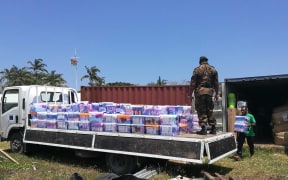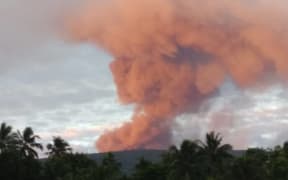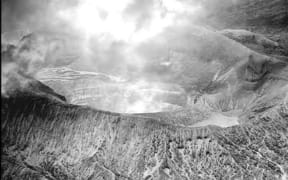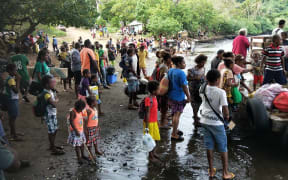A vulcanologist says he saw lava bombs thrown high in to the air during an observation flight over an erupting volcano in Vanuatu.

An aerial photo taken on 25 September by vulcanologist Thomas Boyer of Manaro Voui volcano. Photo: AFP / Thomas Boyer
The Pacific nation's government has ordered a mass evacuation of the island of Ambae, after about a week of escalating volcanic observations of Monaro Voui.
A state of emergency was declared on 26 September.
All 11,000 residents of Ambae - five percent of Vanuatu's population - have been told to evacuate the island. Initially, islanders moved to shelters on Ambae but the government then ordered a mandatory island-wide evacuation.
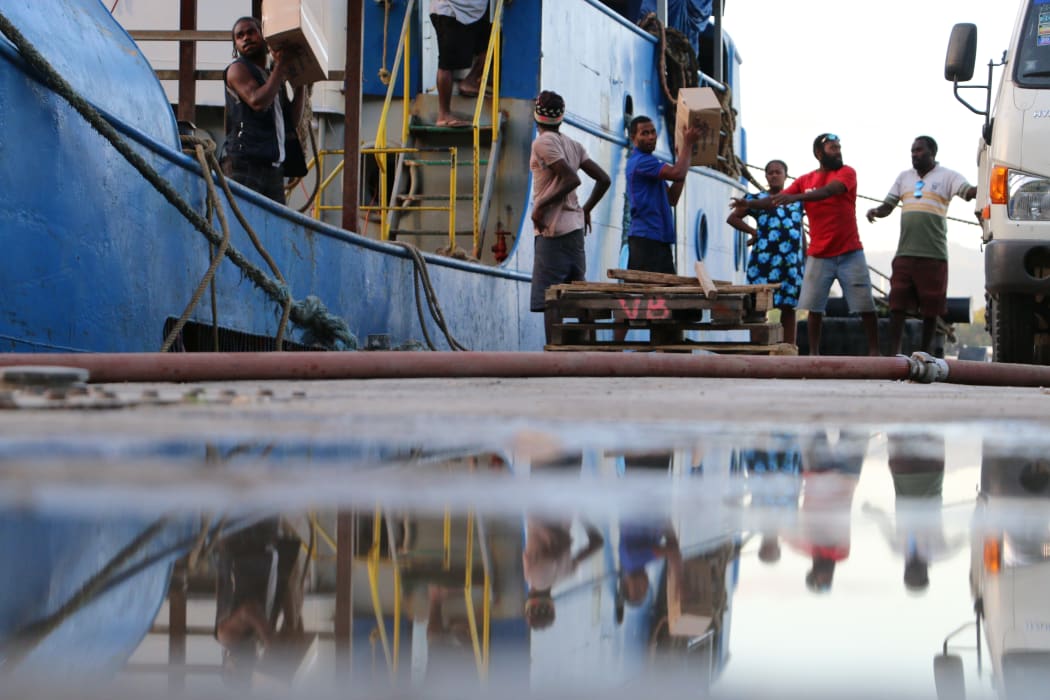
Vanuatu disaster management staff loading donated goods onto a ship heading to Ambae to help with evacuations. Photo: RNZI / Koroi Hawkins
The volcanic alert at the crater is at level four and warnings include gas, acid rain and ash, and lava bombs. Access to clean drinking water has been compromised by the acidic ash fall.
A flotilla of private boats, canoes, and commercial vessels will start to ferry thousands of people to other islands today. The evacuation is expected to take days.
GNS Science vulcanologist Brad Scott arrived in Vanuatu at the weekend in the capital Port Vila to provide expert assistance to the government. On Saturday, he was on an observation flight over Ambae.
He said lava bombs were being thown up into the air every eight to 10 seconds.
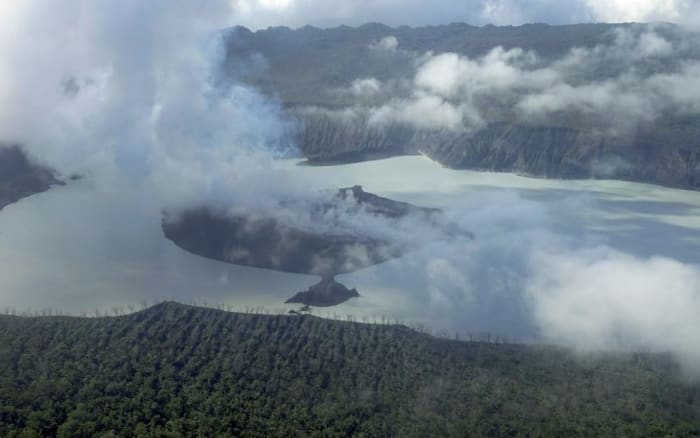
An aerial photo of Manaro Voui volcano on 25 September. Photo: AFP / Thomas Boyer
"Maybe about every 8 to 10 seconds there was an explosion, throwing lava bombs up maybe 50 to 100 metres above the crater and there's also two small lava flows that are flowing across the island into the lake as well."
Mr Scott said he was going on another observation flight on Sunday morning.
There are two other volcanoes active in Vanuatu at the moment, on the islands of Ambrym and Lopevi.
Mr Scott said they were hoping to also assess them today.
The operations manager of Vanuatu's disaster management office, Peter Korisa, said more funding would probably be needed for the compulsory evacuation of the entire population of Ambae.
When the Manaro Voui volcano began belching ash last week the government committed US$2m to initial island evacuations, moving people living close to the volcano and those affected by the ash fall from its eruption to evacuation centres on the eastern and western sides of the island.
Mr Korisa said this has now become a massive operation to evacuate over 10000 people to four different islands using ships, canoes and aircraft.
"[It] is a very limited budget that was allocated by the government and is still, we are using it now. But of course this operation is quite huge so it might, in the future we might need more funding. If there are more needs then of course we will have to request it through the government or elsewhere."
Meanwhile, a ministerial decree was on Friday restricting inbound visitors to Ambae. Mr Korisa said the aim of this was to try and ensure they eventually get everybody off the island.
One of the greatest challenges facing residents fleeing Ambae is access to clean drinking water.
Red Cross emergency officer Andrew McKie was living in Vanuatu during the 1995 eruptions and said volcanic activity on Ambae was nothing new.
"Vanuatu has a long history of volcanic eruptions, it's really right on the ring of fire.
"There's a number of evacuations going on all the time in Vanuatu, there's so many volcanoes there, and the people of Vanuatu are very accommodating."
He said the greatest issue for residents is access to safe drinking water.
"The main problem is the lack of safe drinking supply, that's probably perpetrated the evacuation rather than the danger of lava."
He said the logistics of getting people off the island were not straightforward.
"It's not as easy as rolling out boats and all that. There's reefs and limited boats can get in and evacuate people."
The head of the island's provincial government, Georgewin Garae, has said everyone on the western side of Ambae would go to the country's biggest island, Santo, mostly around the town of Luganville.
People on the east would be split between other islands. Maewo had agreed to take 1125 evacuees, Pentecost would take more than 1000, while Malekula would take several hundred.
The summit of the volcano is 1496 metres above sea level. From the ocean floor, it rises 3900 metres.
New Zealand ready to help
The Foreign Affairs minister Gerry Brownlee said New Zealand stands ready to help in any way it can if asked by the Vanuatu Government.
New Zealand has released pre-positioned emergency relief supplies, such as hygiene and sanitation kits, and $100,000 is available to support the response effort on the ground.
The New Zealand Defence Force undertook a surveillance flight earlier in the week and two GNS vulcanologists are currently in Vanuatu to work with local authorities.
Mr Brownlee said New Zealand officials and the High Commissioner were assessing what was needed.
"The Australians [are] doing quite a bit. The French government are also providing some assistance. So all in all an international effort.
"Given it's in our part of the world we want to contribute to that and are contributing to that. But exactly where to from here will be clearer once that team with the High Commissioner report back to us.
"If this thing goes on for a while, it's going to be very difficult for people there.
"At this stage Vanuatu have made no request of us, we're just in anticipation at the moment."

